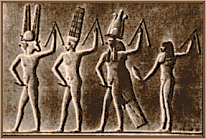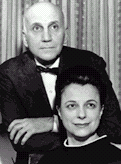THE HISTORY
OF MASTURBATION
 While
there are no direct references to masturbation in cave paintings
or other prehistoric artifacts, the practice of masturbation
by Bonobo chimpanzees, which share 98.4% percent of our
DNA, provides some confirmation that masturbation has likely
been practiced since the dawn of mankind.
While
there are no direct references to masturbation in cave paintings
or other prehistoric artifacts, the practice of masturbation
by Bonobo chimpanzees, which share 98.4% percent of our
DNA, provides some confirmation that masturbation has likely
been practiced since the dawn of mankind.
The Ancient
World
In
the ancient world, depictions of male masturbation are relatively
common. The Egyptians, for example,  celebrated
masturbation as the process by which the sun god, Atum,
created the first Adam and Eve equivalents, Shu and Tefnut.
"With the hand of God, Atun masturbated and brought forth
the first pair of souls."
celebrated
masturbation as the process by which the sun god, Atum,
created the first Adam and Eve equivalents, Shu and Tefnut.
"With the hand of God, Atun masturbated and brought forth
the first pair of souls."
The
Sumerians, who invented the first written Western language,
make reference to the Mesopotamian god Enki masturbating,
his ejaculation filling the Tigris River with flowing water.
Condemnation
of masturbation is as old as fertility-worship and is probably
based on early man’s realization that there is safety
in numbers. A bigger tribe is more likely to gain new territory
and expand its power base. In theory, this is this reason
that any form of sexual pleasure unlikely to result in a
population increase (e.g. masturbation, homosexuality, oral/anal
sex) has routinely been denounced as wrong. While in today’s
overpopulated world this rationale no longer makes logical
sense, this belief structure continues to drive the moral
attitudes of many people.
 In
the Judeo-Christian tradition prevalent throughout Western
society, the main Scripture quoted by Christians to denounce
masturbation is Genesis 38. In biblical times, under Jewish
law, a brother was required to procreate with his brother's
widow. Onan of Judah refused, and "spilled his seed"
(i.e. ejaculate), on the ground instead. This is the origin
of the term Onanism (The Sin of Onan) which is incorrectly
used in place of masturbation — in fact, what really
happened was premature withdrawal (i.e. coitus
interruptus).
In
the Judeo-Christian tradition prevalent throughout Western
society, the main Scripture quoted by Christians to denounce
masturbation is Genesis 38. In biblical times, under Jewish
law, a brother was required to procreate with his brother's
widow. Onan of Judah refused, and "spilled his seed"
(i.e. ejaculate), on the ground instead. This is the origin
of the term Onanism (The Sin of Onan) which is incorrectly
used in place of masturbation — in fact, what really
happened was premature withdrawal (i.e. coitus
interruptus).
18th
& 19th Centuries
 It
was primarily during the 1700s and 1800s when masturbation
was first associated with mental and physical deficiencies.
Some prominent physicians, scientists, philosophers, and
religious leaders believed that illnesses such as insanity,
vision and hearing problems, epilepsy, mental retardation,
and general health problems were caused by self-stimulation.
In fact, over 60% of medical and mental illnesses were blamed
on masturbation.[1]
It
was primarily during the 1700s and 1800s when masturbation
was first associated with mental and physical deficiencies.
Some prominent physicians, scientists, philosophers, and
religious leaders believed that illnesses such as insanity,
vision and hearing problems, epilepsy, mental retardation,
and general health problems were caused by self-stimulation.
In fact, over 60% of medical and mental illnesses were blamed
on masturbation.[1]
The
fear of masturbation was so great that throughout the world,
extreme preventative measures were instituted including
the use of mechanical restraints, genital surgery, and physical
discipline.[2] By the 19th century the cereal magnate John Harvey
Kellogg declared "sex for anything but reproduction"
to be "sexual excess." Kellogg and others began
advocating routine circumcision of males as a deterrent
to masturbation.
The term, spermatorrhea, was even invented
to explain nocturnal emissions, as no man was willing to
admit to masturbating. Between 1856 and 1932, the U.S. Patent
Office, awarded 33 patents to inventors of anti-masturbation
devices.
Here are some examples antimasturbation devices:
1.
Simple Bondage-- For
some, the simple answer was to tie the masturbators up and
prevent them from touching themselves.
2.
Leather-Jacket Corset--
A corset made out of leather and steel to be used by boys,
was created by Dr. Fleck in 1831. It included a metal penis
tube and "a steel band riveted to the shield permanently
and attached to the body with an encircling steel band in
such a manner that it cannot be removed and prevented access
to the testicles." The doctor once reported that "it
closes with greatest accuracy, fits to perfection, and the
boy wears it continuously without having succeeded even
once in reaching his genitals or pulling the machine away
from his body so as to produce friction on his genitals."
3. Spike-lined Ring--
Created to prevent the nocturnal emissions and any display
of nighttime sexuality, spike-lined penis rings were created
in the 1950's by doctors in Boston.
4. Spermatorrhea Bandage--
These devices kept the penis tightly bound, thus making
it impossible to have an erection.
5. Stephenson Spermatic
Truss-- Patented in 1876, this device placed the penis in
a pouch, and then stretched and tied down between the legs,
which made erection impossible. Stephenson changed his device
slightly 21 years later, adding a metal hood under which
the penis could move freely. Any erection would drive the
penis against painful spikes.
6. Bowen Device-- This
device was like a cup that was placed over the head of the
penis and attached to pubic hair by chains and clips. When
the wearer got an erection, the pubic hair would be plucked
painfully and the wearer would have to respond.
 7. The Cage-- The Handbook
of Medicine in 1885 offered a metal cage that could
be put around a boys genitals. It would allow erections,
which weren't seen as wrong, yet would prevent the boy from
touching himself.
7. The Cage-- The Handbook
of Medicine in 1885 offered a metal cage that could
be put around a boys genitals. It would allow erections,
which weren't seen as wrong, yet would prevent the boy from
touching himself.
8. Dr. Moodie Apparatus
for Boys-- Scotch physician John Moodie invented this truss-and-shield
device in 1848. It included a penis tube with a slot on
the side for the boy to push his penis out in order to urinate.
9. Penis-Cooling Devices--
These devices cooled an impending erection with either air
or water; Frank Orth invented both types and patented them
in 1893. He said that "the penis is inserted in the
hole and between the levers so that if during the night
an erection occurs, the dilatation of the penis spreads
the levers, thus separating the jaws, and permitting the
cold water to flow through the tube to the sack or envelope.
The cold water... cools the organ of generation, so that
the erection subsides and no discharge occurs."
10. Sexual Armor-- A jacket
with leather pants which supports a large piece of steel
armor. Perforations in the armor allowed urine to escape,
yet the bolted, padlocked trapdoor at the rear would have
to be opened for other business...
Information
from Sex
Lovers Book of Lists by Ron Louis and David Copeland
http://datingfun.com/sex/masturbation/antidevices.asp
20th
Century
In the 20th Century, individuals within the medical
community began questioning whether or not masturbation
was independent from the various psychiatric and medical
illnesses to which it was historically linked.  During
the 1950s and 1960s, with greater discussion of sex and
sexuality and lessening conservative social attitudes along
with greater medical research on the topic of masturbation,
the thought that the act of self-stimulation is associated
with medical and mental illnesses dissipated.
During
the 1950s and 1960s, with greater discussion of sex and
sexuality and lessening conservative social attitudes along
with greater medical research on the topic of masturbation,
the thought that the act of self-stimulation is associated
with medical and mental illnesses dissipated.
Beginning with the Kinsey Report of 1948, masturbation was
demystified and even discovered to be beneficial. In 1966,
Masters & Johnson (see photo) revealed the practice
to be virtually universal in North America, cutting across
all boundaries of sex, age, race, and social class. In 1971
Goldstein, Haeberle & McBride determined masturbation
to be the most common form of sexual activity among humans.
Today
It is clear that masturbation has had a dynamic
and varied history. It now almost universally accepted
by the medical community that masturbation is a common,
safe, and normal practice which occurs in infants, teenagers,
and adults.
 Despite
this new attitude, the actual practice and discussion of
masturbation continues to be a social taboo within most
societies. Former Surgeon General Jocelyn Elder was immediately
dismissed by President Clinton in 1994 after she stated
that masturbation “is something that is part of human
sexuality and its part of something that perhaps should
be taught.”[3]
Despite
this new attitude, the actual practice and discussion of
masturbation continues to be a social taboo within most
societies. Former Surgeon General Jocelyn Elder was immediately
dismissed by President Clinton in 1994 after she stated
that masturbation “is something that is part of human
sexuality and its part of something that perhaps should
be taught.”[3]